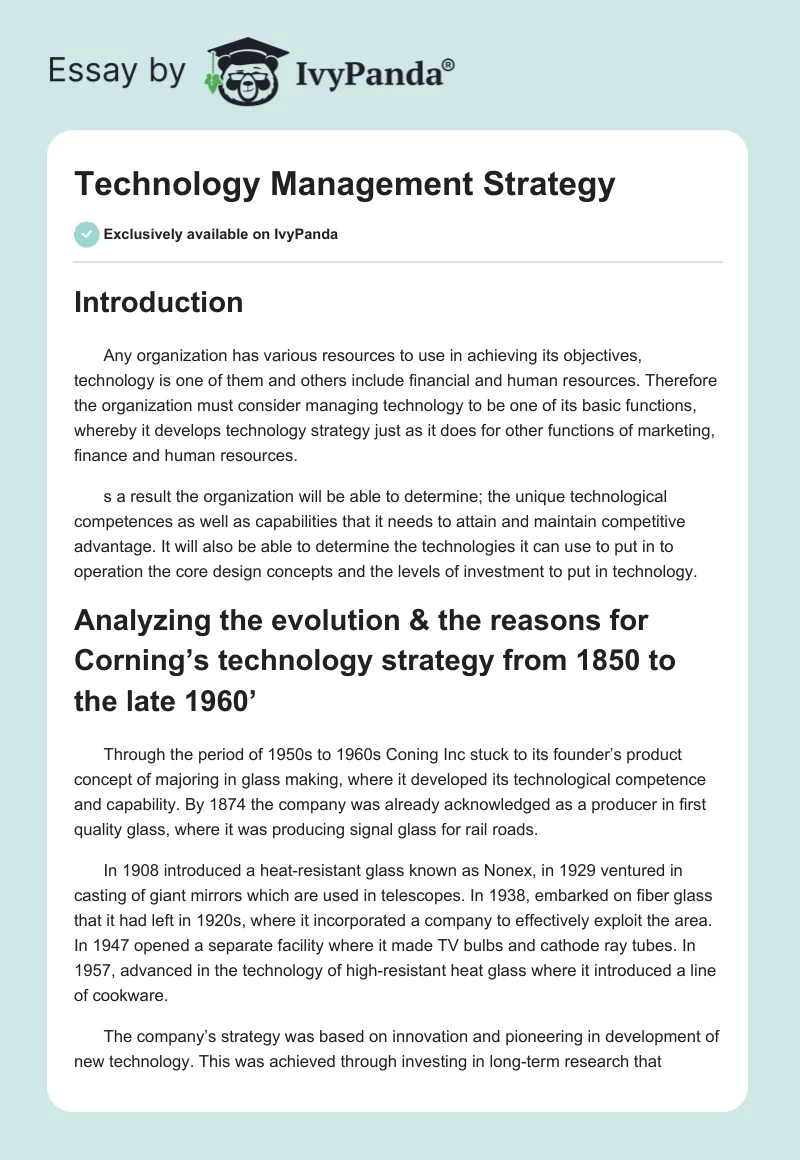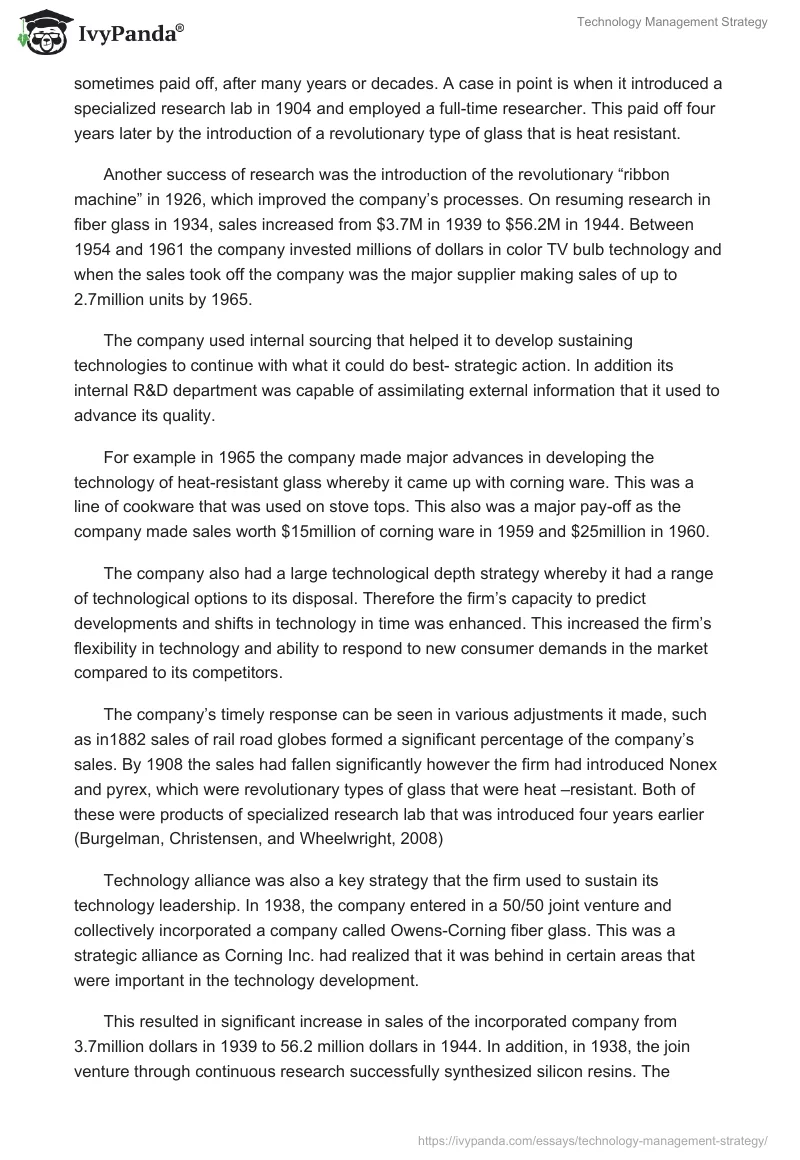Introduction
Any organization has various resources to use in achieving its objectives, technology is one of them and others include financial and human resources. Therefore the organization must consider managing technology to be one of its basic functions, whereby it develops technology strategy just as it does for other functions of marketing, finance and human resources.
s a result the organization will be able to determine; the unique technological competences as well as capabilities that it needs to attain and maintain competitive advantage. It will also be able to determine the technologies it can use to put in to operation the core design concepts and the levels of investment to put in technology.
Analyzing the evolution & the reasons for Corning’s technology strategy from 1850 to the late 1960’
Through the period of 1950s to 1960s Coning Inc stuck to its founder’s product concept of majoring in glass making, where it developed its technological competence and capability. By 1874 the company was already acknowledged as a producer in first quality glass, where it was producing signal glass for rail roads.
In 1908 introduced a heat-resistant glass known as Nonex, in 1929 ventured in casting of giant mirrors which are used in telescopes. In 1938, embarked on fiber glass that it had left in 1920s, where it incorporated a company to effectively exploit the area. In 1947 opened a separate facility where it made TV bulbs and cathode ray tubes. In 1957, advanced in the technology of high-resistant heat glass where it introduced a line of cookware.
The company’s strategy was based on innovation and pioneering in development of new technology. This was achieved through investing in long-term research that sometimes paid off, after many years or decades. A case in point is when it introduced a specialized research lab in 1904 and employed a full-time researcher. This paid off four years later by the introduction of a revolutionary type of glass that is heat resistant.
Another success of research was the introduction of the revolutionary “ribbon machine” in 1926, which improved the company’s processes. On resuming research in fiber glass in 1934, sales increased from $3.7M in 1939 to $56.2M in 1944. Between 1954 and 1961 the company invested millions of dollars in color TV bulb technology and when the sales took off the company was the major supplier making sales of up to 2.7million units by 1965.
The company used internal sourcing that helped it to develop sustaining technologies to continue with what it could do best- strategic action. In addition its internal R&D department was capable of assimilating external information that it used to advance its quality.
For example in 1965 the company made major advances in developing the technology of heat-resistant glass whereby it came up with corning ware. This was a line of cookware that was used on stove tops. This also was a major pay-off as the company made sales worth $15million of corning ware in 1959 and $25million in 1960.
The company also had a large technological depth strategy whereby it had a range of technological options to its disposal. Therefore the firm’s capacity to predict developments and shifts in technology in time was enhanced. This increased the firm’s flexibility in technology and ability to respond to new consumer demands in the market compared to its competitors.
The company’s timely response can be seen in various adjustments it made, such as in1882 sales of rail road globes formed a significant percentage of the company’s sales. By 1908 the sales had fallen significantly however the firm had introduced Nonex and pyrex, which were revolutionary types of glass that were heat –resistant. Both of these were products of specialized research lab that was introduced four years earlier (Burgelman, Christensen, and Wheelwright, 2008)
Technology alliance was also a key strategy that the firm used to sustain its technology leadership. In 1938, the company entered in a 50/50 joint venture and collectively incorporated a company called Owens-Corning fiber glass. This was a strategic alliance as Corning Inc. had realized that it was behind in certain areas that were important in the technology development.
This resulted in significant increase in sales of the incorporated company from 3.7million dollars in 1939 to 56.2 million dollars in 1944. In addition, in 1938, the join venture through continuous research successfully synthesized silicon resins. The product was used as lubricants and also acted as substitutes of rubber in many functions (Burgelman, Christensen, and Wheelwright, 2008).
Corning’s technology strategy during the period of1970 to 2000
By early 1970s the company had started investing in fiber-optics technology, which was a clear shift from its glass making technology. Here the company saw potential though it was still early to realize the benefits and also the company did not have complimentary assets to cater for the large costs that come with innovation.
The company nearly shut down this project, however in 1973 it got in to a strategic alliance with Siemens in a joint venture partnership. Through this they were able to make optical fiber cables. The access to complimentary assets from already established Siemens enhanced Corning’s capacity to exploit the opportunities, whereby it built a pilot plant that was full-scale and also invested more than $100million by late 1981 in optical waveguides.
Another shift in 1970 was venturing in to automobile industry of which after four years of research $100M worth of sales were made. In addition Corning also invested heavily in medical products which saw sales move from $3million in 1970 to $30 million after four years. It also made major acquisition of $125 M of Medpath to enhance its medical line.
As a result of shift from the glass industry the company needed to develop core competencies in these new industries, hence in 1983 the company dropped operations of automobile industry and focused its resources in the remaining two. This can be explained through the concept of dominant technology trajectories whereby it states that industries go through cycles (Kristinsson & Rao, n.d).
There is emergence stage whereby an innovation is discovered, then development stage whereby various designs of the same innovation are realized by different firms. Lastly these various designs compete in the market and through process and product designs, as a result some firms drop out of the industry.
One or a few firms become dominant suppliers and the remaining resort to niche markets. This is seen by the way Corning drops out from automobile industry in 1983 and out of medical industry in 1996. At the emergence stage there were different firms that were venturing into the telecommunications industry (optical waveguides), including some of the 150 firms in the industry. Each firm is trying to come up with new commercial processes and products through research in this technological trajectory (Kristinsson & Rao, n.d).
In 1996 Corning Inc. set clear goals to pursue telecommunications innovations and as a result it aggressively invested in photonics and optical fibers. Different technological trajectories emerged with Corning Inc.‘s being one of them. As the industry heads to maturity the main players are now clearly identifiable, as they have distinctive and quality products. In line with this Corning came up with a range of sophisticated products, that put it amongst the main players.
Then there is the dominance stage, whereby the technology trajectory of one of the firms achieves dominance. Corning Inc. became dominant by the end of 2000, whereby it made sales of $5biilion out of the total market worth of $7billion. In addition the company made acquisitions of other rival companies which were significant to deepening its expertise in the innovations (Kristinsson & Rao, n.d).
Challenges faced by Joe Miller, Corning’s Chief Technological Officer, faces in 2003?
One of the challenges is competence trap or core rigidity, whereby a firm can be so focused and competent in a given area such that in case of drastic changes in the industry then the firm might fall. Here Corning Inc was so much competent in telecommunications industry such that when the industry nose-dived, the company ran out of options.
Another challenge can be explained through the S-curve concept, whereby the curve has four phases, which are initial stage, growth, and decline. The industry had reached decline stage, therefore the chief Technological Officer had to decide whether the firm should exit the industry or it should re-invent itself. Other challenges were, determining if the decline was temporary, determining other potential industries that the firm could venture in to incase the current one failed (Forster, n.d).
References
Burgelman, R. A., Christensen, C. M. and Wheelwright, S. C. (2008). Strategic Management of Technology and Innovation. New York, NY: McGraw-Hill Irwin.
Forster, R. D. Description of the S curve (n.d.) Web.
Kristinsson & Rao The Emergence of Dominant Technology Trajectories in the US Medical; Device Industry (n.d.) Web.
Management of Technology–Design and Implementation of Technology Strategy. n.d. Web.


